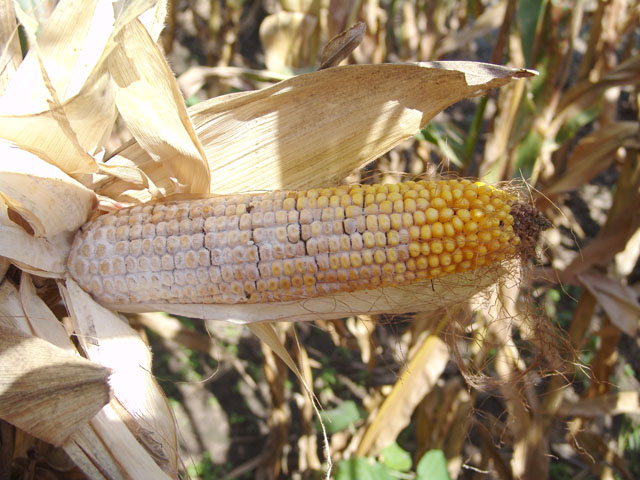What is Diplodia Ear Rot?
The most characteristic symptom, and the easiest way to tell diplodia ear rot apart from other ear diseases such as Gibberella and Fusarium ear rots, is the presence of white mycelium of the fungus growing over and between kernels, usually starting from the base of the ear. Under highly favorable weather conditions, entire ears may become colonized, turn grayish-brown in color and lightweight (mummified), with kernels, cobs, and ear leaves that are rotted and soft. Rotted kernels may germinate prematurely, particularly if the ears remain upright after physiological maturity. Corn is most susceptible to infection at and up to three weeks after silk emergence (R1). Wet conditions and moderate temperatures during this period favor infection and disease development, and the disease tends to be most severe in no-till or reduce-till fields of corn planted after corn. The greatest impact of this disease is grain yield and quality reduction. Mycotoxins haven’t been associated with this disease in the U.S., but animals often refuse to consume contaminated grain.
There is a lot of information available on this disease. These websites have more information.
- Purdue University - Diseases of Corn: Diplodia Ear Rot
- The Bulletin - Diplodia Ear Rot of Corn
- Townhall.com - Corn Mold Lurks In U.S. Fields, Threatening Crop Yields
- Iowa State University - Mycotoxin Contamination of Corn: What it is, what it does to pigs and what can be done about it
MPCI Claims for Diplodia Ear Rot
When making a claim for diplodia ear rot, keep in mind the following:
- Crops covered under the Common Crop Insurance Policy do have coverage for damage such as this under the quality adjustment portion of the provisions.
- Diplodia (as explained in the web articles listed above) is NOT considered a toxin and therefore the damage it causes will be restricted first to lower yields and then to quality issues of kernel damage and low test weight in the harvested grain.
- Quality adjustment for low test weight on corn begins when the test weight drops below 49 pounds.
- Quality adjustment for kernel damage is available on corn when damage exceeds 10 percent.
- For quality adjustment, samples:
- Of farm stored grain must be pulled by our adjuster.
- Of delivered grain may be accepted, if pulled by USWA licensed warehouses and those holding a storage agreement with the CCC.
- Samples must be graded by a grain grader licensed under the USGSA or the USWA, or by a grader licensed under state law with a CCC storage agreement.
- Your quality adjustment Special Provisions have pre-established discount factors that will be used when corn is eligible quality adjustment. So regardless of what discount is applied by the grain buyer, the discount used for a claim is set by the provisions.
- Corn hybrids vary in their susceptibility to diplodia ear rot.
- If an insured discovers damage that appears significant enough to warrant quality adjustment, he should:
- Keep the damaged acreage/grain separate from undamaged grain—comingling grain may compromise the integrity of the sample. Note: Obtaining a representative sample from farm stored grain may involve coring the bin by unloading 50 to 100 bushel depending on the size of the bin.
- Report any claim on a timely basis. An adjuster will contact the insured to discuss their options.


